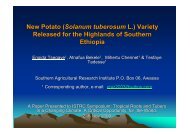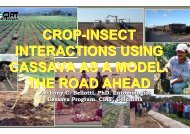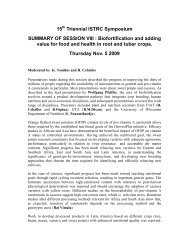Naskar, S.K; Progress and status of yam bean (Pachyrhizus sp.)
Naskar, S.K; Progress and status of yam bean (Pachyrhizus sp.)
Naskar, S.K; Progress and status of yam bean (Pachyrhizus sp.)
Create successful ePaper yourself
Turn your PDF publications into a flip-book with our unique Google optimized e-Paper software.
YAM BEAN GROWING STATES IN INDIA513241. North Bihar2. West Bengal3. Assam4. Orissa5. Uttar Pradesh
Striking features• Good adaptability to a wide range <strong>of</strong> climatic <strong>and</strong> edaphicconditions• Well balanced <strong>and</strong> nutritious composition <strong>of</strong> protein/starch contents• Acceptable taste• Good post harvest/ storage characters• Biological N fixation
Field View <strong>of</strong> Yam Bean
Flowering in Yam Bean
Tubers <strong>of</strong> Yam Bean
Yam Bean Research in India• Breeding Efforts• Agronomic Research• Insecticidal properties <strong>of</strong> <strong>yam</strong> <strong>bean</strong> extract• Future thrust
Breeding Efforts in Yam Bean• Not received much attention• Farmers in the country still rely on traditional l<strong>and</strong> races• Research on Yam Bean is being carried out at:• Central Tuber Crops Research Institute (CTCRI),Thiruvananthapuram, Kerala, India• Two centers (Bihar <strong>and</strong> West Bengal) <strong>of</strong> the All India Co-ordinatedResearch Project on Tuber Crops (AICRPTC)
Germplasm Accessions• CTCRI: 63 ; AICRP centres: 205• Accessions comprises <strong>of</strong> l<strong>and</strong> races <strong>and</strong> exotic collections• Most <strong>of</strong> the exotic collections are from Mexico• All the accessions were characterized <strong>and</strong> evaluated• One white flower accession, the remaining accession<strong>sp</strong>roduce velvet flowers• Tuber yield ranged between 10.33-25.78 t ha -1• Variations in dry matter (9.33-29.78%), starch (3.02-7.96%)<strong>and</strong> sugar (3.02-7.96%)• Six accessions with yield more than 25 t ha -1• Maximum yield <strong>of</strong> 29.3 t ha -1 in accession EC 100566(Vimala <strong>and</strong> Bala Nambisan, 2005)
Induction <strong>of</strong> Variability through Mutagenesis• Genetic variability is limited• Exploratory gamma irradiation was carried out in seed samples <strong>of</strong>a superior collection (Sreekumari et al., 1983; Nair <strong>and</strong> Abraham,1988,1989)• Gamma radiation (5 - 25 kR) or ethylmethane sulphonate(EMS, 0.5 – 1.25%) induced greater variability: shoot length,number <strong>of</strong> branches, number <strong>of</strong> leaves <strong>and</strong> tuber yield• Gamma radiation greater than 7.5 kR significantly reducedvegetative vigour <strong>and</strong> yield• Gamma radiation (5 kR) stimulated vegetative vigour, greatershoot length, number <strong>of</strong> branches, number <strong>of</strong> leaves <strong>and</strong> tuberyield• Occurrence <strong>of</strong> multiple shoot (Sreekumari <strong>and</strong> Abraham,1980)
Breeding <strong>of</strong> Yam Bean• Breeding in <strong>yam</strong> <strong>bean</strong> is limited to selection only• Breeding objectives include:• Earliness• High dry matter• Improved nutrition• Drought tolerance• Pest <strong>and</strong> disease resistance• Virus resistance
Varieties•In India two types <strong>of</strong> cultivars (Mexican <strong>and</strong> local) are grown•Mexican types are larger in size <strong>and</strong> attain a diameter <strong>of</strong>10-15 cm <strong>and</strong> weigh up to 1.5 – 2.0 kg•Mexican types are less sweet compared to local ones <strong>and</strong>develop cracks on tubers•Local types have smaller tubers (200 – 300 g), moderate tohigh sweetness, less fibre, conical shape, white flesh <strong>and</strong>are s<strong>of</strong>t with creamy skin•They do not develop cracks on tubers
Rajendra Mishrik<strong>and</strong> 1 (RM-1)• An improved selection (Singh et al. 1981)• Released by the AICRP on tuber crops, very popular inBihar <strong>and</strong> West Bengal• Average tuber yield 40 – 55 t ha -1 in 110 – 140 days• Individual tuber weighs 0.6 – 0.7 kg, is sweeter,comparatively free from cracking with smooth surface• Napiform shape <strong>and</strong> cream coloured tuber skin• Flesh is white• Other promising Mexican line L-19 gives better yield inBihar, West Bengal <strong>and</strong> Orissa
Promising Accessions <strong>of</strong> Yam BeanDPH 9 DPH 101DPH 70 DPH 88
Production Technologies for Yam BeanTime <strong>of</strong> sowingNutrient managementStates/RegionNE India, OrissaWest Bengal, Uttar PradeshRain- fedJune-JulySep-OctBiharStateFYM ( t ha -1 ) +NPK (kg ha -1 )FYM 15-20 t ha -180 :40: 80Time <strong>of</strong> sowing varies from June-SepSpacingTamil NaduWest Bengal80 : 60: 80120:60:80NormallySmall tuberproductionOrissa30 x 30cm30 x 15 cm15 x 15 cm60 x 60 cm60 x 30 cmEntire P <strong>and</strong> K, half N as basal at the time<strong>of</strong> sowing ; remaining N at 40-50 DASSeed rate: 20-60 kg ha -1
Growth <strong>and</strong> Tuber Yield <strong>of</strong> Yam Bean as affected by Sowing DatesSowingdatesDry weight (g/plant)at 45 daysTopTuberDry weight (g/plant)at harvest (120 days)TopTuberFresh tuberweight(t/ha)L-19RM-1L-19RM-1L-19RM-1L-19RM-1L-19RM-1Sept 126.36.610.8310.1112.5014.4040.738.333.8731.99Sept 174.34.88.258.229.6911.9838.637.132.2325.50Oct 103.53.85.665.427.668.9936.634.731.0328.21Oct 252.82.02.101.726.256.8813.012.711.6110.20Nov 101.01.2--3.904.508.36.66.835.50Nov 250.90.8--3.002.804.84.34.033.33C.D (0.05)1.372.50Source : Sen et al.(1996)
Influence <strong>of</strong> <strong>sp</strong>acing <strong>and</strong> time <strong>of</strong> harvesting on dry matter production<strong>and</strong> tuber yield <strong>of</strong> <strong>yam</strong> <strong>bean</strong>TreatmentsDry matter production/plant (g)ShootTuberTotalTuber yield/plant g)Tuberyieldha (t ha -1 )Spacing60 x 20 cm60 x 3060 x 4560 x 60CD (0.05)20.923.127.229.14.522.526.432.934.62.943.449.560.164.34.293.8109.8137.2144.312.06.165.254.623.890.50Time <strong>of</strong> harvesting75 DAS90 DAS105 DAS120 DASCD (0.05)9.821.130.739.74.514.327.936.537.72.924.149.067.277.44.259.7116.2151.9157.212.02.765.045.976.160.50Source : Nedunzhiyan et al. (2001) (2002)
Tuber yield <strong>and</strong> TSS <strong>of</strong> Yam Bean as affected by Nitrogen, Potassium <strong>and</strong> VarietyTreatmentsTuber yield (t/ha)19861987PooledTotalSolubleSolids(%)N40N80N120C.D (0.05)K40K80K120C.D. (0.05)V1 (RM-1)V2 (L-19)C.D. (0.05)31.0835.5241.624.1334.4136.6337.18NS35.5236.07NS20.0625.3424.350.8722.6024.0623.0.90.8723.7822.820.0425.7830.6632.892.0928.4430.6630.222.0929.7729.33NS6.906.646.46-6.696.626.68-7.026.30-Source : Sen <strong>and</strong> Mukhopadhyay (1989)
Flower pruningNegative correlation between tuber yield <strong>and</strong> pod formation;De-flowering by <strong>sp</strong>raying 2,4-D (50 ppm) at flower initiation stageSpraying NAA (1500 ppm) at flower bud initiation stageFlower pruning increases vegetative cycle without changing N fixationAmount <strong>of</strong> N fixed was 163-216 kg ha -1After careWeed infestation more in June-August crop than September sown cropMulching enables weed control, regulation <strong>of</strong> soil temperature <strong>and</strong>moisture conservationFirst interculturing at 40 DAS along with top-dressing <strong>and</strong> earthing upSecond weeding after 30 days <strong>of</strong> first weedingFYMWater managementNo irrigation for June-July crop; September crop 1-2 irrigationsPaddy straw mulching - 26.4% higher yield than rain-fed crop
Water managementTreatmentsTuberyield(t/ha)Averagetuberweight(g/plant)HarvestIndex(%)QualityStarch(%)Totalsugar(%)T1 30 DAST2 60 DAST3 30 + 60 DAST4 30+ 60 + 90 DAST5 Straw mulchT6 RainfedS.Em(± )CD (0.05)25.1421.1121.4419.5526.2619.891.584.76231.00205.12106.26190.00255.17193.006.8820.7384.2583.6982.1279.8484.8785.271.27NS3.103.204.004.503.002.900.050.152.212.192.141. 992.152.320.0140.042• DAS: Days after SowingSource : Jana (2005)
Promising Cropping Systems Involving Yam BeanStateWest BengalNorth BiharIntercroppingYam <strong>bean</strong> + pigeon pea ( 3:1)Yam <strong>bean</strong> + maizeSequential cropYam <strong>bean</strong> + pigeon pea- mung<strong>bean</strong>Cowpea ( fodder)-jute-<strong>yam</strong> <strong>bean</strong>,maize-rice- <strong>yam</strong> <strong>bean</strong>,sesame-rice-<strong>yam</strong> <strong>bean</strong>,green gram- upl<strong>and</strong> taro- <strong>yam</strong><strong>bean</strong>,green gram- elephant foot <strong>yam</strong><strong>yam</strong><strong>bean</strong>ground nut- rice-<strong>yam</strong> <strong>bean</strong>Kharif maize – <strong>yam</strong> <strong>bean</strong> – onionKharif maize-<strong>yam</strong> <strong>bean</strong>- wheat +moongHarvesting: after 150 days ( ideal 90-105 days);Yield: Local- 18-20 t ha -1 , Improved- 40-45 t ha -1Pr<strong>of</strong>it : Rs. 12,000-15,000/ha
Yam Bean as a barrier crop• Yam <strong>bean</strong> was found to be an effective barrier crop againstsweet potato weevil ( AICRPTC, 2009)Pests <strong>and</strong> disease management• No serious pests• Root rot ( Sclerotium rolfsii ) <strong>and</strong> mosaic are common diseases• When grown for seed purpose, pod borer becomes seriousFYM
Bio-pesticides from <strong>yam</strong> <strong>bean</strong> seed extract• Yam <strong>bean</strong> seed extract was effective as a bio-pesticide againstaphids <strong>and</strong> leaf eating caterpillarsInsecticidal properties <strong>of</strong> <strong>yam</strong> <strong>bean</strong> extract• Mature seeds <strong>of</strong> <strong>yam</strong> <strong>bean</strong> contain a toxic compound called rotenone(C 23H 22O 6) which has insecticidal properties• Petroleum ether extract <strong>of</strong> <strong>yam</strong> <strong>bean</strong> seed (YBSE) 3% was effectiveagainst adults <strong>of</strong> Sitophilus oryzae <strong>and</strong> larvae <strong>and</strong> adults <strong>of</strong> Triboliumcastaneum• Yam <strong>bean</strong> seed extract (1%) gave very high mortality (over 95%) at 5FYMDAT <strong>of</strong> field pests such as Aphis craccivora Koch (cowpea aphids),Spilosoma obliqua Walker (Bihar hairy caterpillar), Spodoptera lituraFabricius (army worm) <strong>and</strong> Pericallia ricini Fabricius (castor defoliator)
Future Thrust• Scientific knowledge has to be generated about the production <strong>and</strong>chemical constituents <strong>of</strong> this crop to exploit the potential <strong>of</strong> the crop• There is scope for extending its cultivation to non-traditional areas• All the wildest possible endangered l<strong>and</strong> races <strong>of</strong> <strong>yam</strong> <strong>bean</strong> shouldbe conserved both in situ <strong>and</strong> ex situ• Early maturing, high yielding varieties with improved nutritionalqualities, resistance to biotic <strong>and</strong> abiotic stress has to be developed• Low cost crop management practices need to be st<strong>and</strong>ardized forhigh yield <strong>and</strong> quality <strong>of</strong> <strong>yam</strong> <strong>bean</strong>• Need to study fatty acid composition <strong>of</strong> varieties <strong>and</strong> evaluation <strong>of</strong>seed for oil content <strong>and</strong> processing for eliminating rotenone fromseedsFYM• Exploitation <strong>of</strong> <strong>yam</strong> <strong>bean</strong> pods on a commercial basis for production<strong>of</strong> rotenone based crop protective agents
THANK YOU ANDWELCOME TOCTCRI











